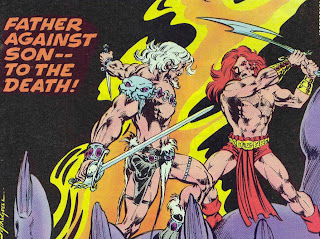Since issue #51 of
Warlord was a reprint of issue #1, I thought I’d take this installment of
Warlord Wednesday to look back over the series so far and pick my favorite issues. Here are my top ten, in chronological, rather than rank order:
First Issue Special #8: Where it all began. Maybe not the best story, but it establishes the essential Edgar Rice Burroughs elements: a fighting man from our world transported to another, and a beautiful princess to be won. I might also add, a figure of religion as a baddie in the form of Deimos.
#3: Lizard Men cargo-cults, a ruined city of a more technologically advanced civilization, and a giant snake creature, make for great pulp adventure. And Machiste--tragically underused once he gets paired off with Mariah--in here in his prime.
#10: A battle of the sexes with Morgan and Machiste versus Mariah in a race to the top of tower to win a magical artifact.
#21: The culmination of a three-parter that is itself the culmination of the Second Deimos Saga that began in issue #15. Father against son with a tragic ending that will reverberate through the series until its very end in the most recent volume.
#22: Warlord playing Sword & Sorcery hero, drowning his sorrows in drink, and taking on a werebeast in a tower, where all is not as it seems.
#25: Still in Sword & Sorcery mode, Morgan turns mercenary, battles snow giants, and spars (with sword and quip) with Ashir, the second best thief in Skartaris.
#38: Morgan’s daughter, Jennifer, comes to Skartaris. Not the most action-packed issue, but gives some insights into Morgan’s character and past.
#46: Morgan goes to the realm of death to save the soul of Shakira!
#48: Morgan and Shakira have one of their usual arguments, and Shakira’s proven right as Morgan attempts to play hero and stop a human sacrifice where all is not as it first appears. Includes one of the series most clever reminders of the relationship between Skartaris and the Outer Earth.
#50: The entire supporting cast appears for a “final” showdown with Deimos. It could be subtitled “revenge is a dish best served cold.”



























